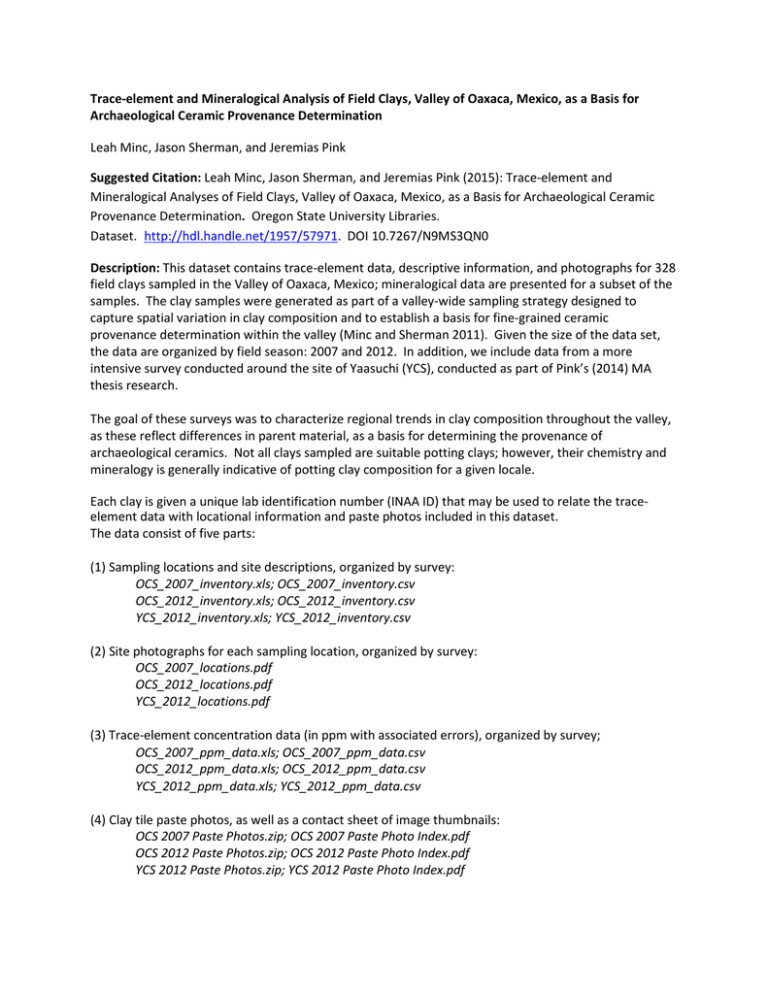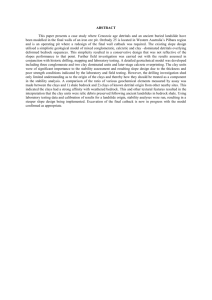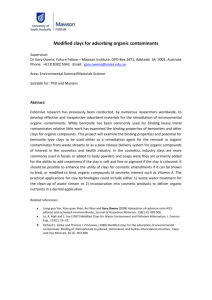Document 10471250
advertisement

Trace-element and Mineralogical Analysis of Field Clays, Valley of Oaxaca, Mexico, as a Basis for Archaeological Ceramic Provenance Determination Leah Minc, Jason Sherman, and Jeremias Pink Suggested Citation: Leah Minc, Jason Sherman, and Jeremias Pink (2015): Trace-element and Mineralogical Analyses of Field Clays, Valley of Oaxaca, Mexico, as a Basis for Archaeological Ceramic Provenance Determination. Oregon State University Libraries. Dataset. http://hdl.handle.net/1957/57971. DOI 10.7267/N9MS3QN0 Description: This dataset contains trace-element data, descriptive information, and photographs for 328 field clays sampled in the Valley of Oaxaca, Mexico; mineralogical data are presented for a subset of the samples. The clay samples were generated as part of a valley-wide sampling strategy designed to capture spatial variation in clay composition and to establish a basis for fine-grained ceramic provenance determination within the valley (Minc and Sherman 2011). Given the size of the data set, the data are organized by field season: 2007 and 2012. In addition, we include data from a more intensive survey conducted around the site of Yaasuchi (YCS), conducted as part of Pink’s (2014) MA thesis research. The goal of these surveys was to characterize regional trends in clay composition throughout the valley, as these reflect differences in parent material, as a basis for determining the provenance of archaeological ceramics. Not all clays sampled are suitable potting clays; however, their chemistry and mineralogy is generally indicative of potting clay composition for a given locale. Each clay is given a unique lab identification number (INAA ID) that may be used to relate the traceelement data with locational information and paste photos included in this dataset. The data consist of five parts: (1) Sampling locations and site descriptions, organized by survey: OCS_2007_inventory.xls; OCS_2007_inventory.csv OCS_2012_inventory.xls; OCS_2012_inventory.csv YCS_2012_inventory.xls; YCS_2012_inventory.csv (2) Site photographs for each sampling location, organized by survey: OCS_2007_locations.pdf OCS_2012_locations.pdf YCS_2012_locations.pdf (3) Trace-element concentration data (in ppm with associated errors), organized by survey; OCS_2007_ppm_data.xls; OCS_2007_ppm_data.csv OCS_2012_ppm_data.xls; OCS_2012_ppm_data.csv YCS_2012_ppm_data.xls; YCS_2012_ppm_data.csv (4) Clay tile paste photos, as well as a contact sheet of image thumbnails: OCS 2007 Paste Photos.zip; OCS 2007 Paste Photo Index.pdf OCS 2012 Paste Photos.zip; OCS 2012 Paste Photo Index.pdf YCS 2012 Paste Photos.zip; YCS 2012 Paste Photo Index.pdf Each folder contains paste micro-photographs taken on a fresh break with an incident light microscope at 50 and 100 power magnification. File-names specify INAA ID and magnification (e.g., OCS_001_50x). (5) Clay mineralogy for a subset of samples. OCS_Petrography.zip Analytical Protocols: Sample selection. The OCS was a vehicle and pedestrian survey. Using 1:50000 topo maps as guides, we drove along secondary and tertiary roads monitoring the roadside and landscape for locations where soils were exposed. At each exposure, the soil profile was examined for clayey strata and samples tested using the ribbon technique. If clays were present, these were sampled, the profile was briefly described, and locational coordinates were recorded. We also took a series of photos (contained in this file) to document the context and appearance of the sampling location. Sample Preparation. All clay samples were exported to the OSU Archaeometry Lab for processing. The dried clays were first gently crushed and then rehydrated with deionized water; these were then formed into small tiles (ca. 2 x 3 cm), which were dried and fired at 800 C for 1 hour in an oxidizing environment. The quality and workability of the clays in the forming process was described, and both tile mass and Munsell color were recorded before and after firing. Approximately one half of the tile was broken off and pulverized in an agate mortar and pestle, and the powdered clay material archived in a glass scintillation vial. Finally, clay pastes were photographed on the fresh break of the remaining half tile, at 50x and 100x using a digital fiber-optic microscope. Remaining tiles were archived for future analyses for most clay locations. INAA Protocols and Analyses. All clay samples were characterized for a suite of 30 major, minor, and trace elements, through a protocol of two neutron irradiations in the OSU TRIGA reactor and multiple counts of gamma activity. To quantify elements with short half-life isotopes, approximately 250 mg of pulverized material was encapsulated in high-purity polyethylene vials, and delivered via pneumatic 13 -2 -1 tube to an in-core location with a nominal thermal neutron flux of 10 n ∙ cm ∙ s . The 7-s irradiation was followed by two separate counts of resultant gamma activity, one after a 15-minute decay (for Al, Ca, Ti, and V) and a second count after 2-hr decay (for Dy, Mn, K, and Na); both counts were for 540 seconds using a 25-30% relative efficiency HPGe detector. To quantify elements with intermediate and long half-live isotopes, sample materials were subjected to a 14-hr irradiation in the rotating rack of the reactor, a location that experiences a nominal thermal 12 -2 -1 neutron flux of 2.3 x 10 n ∙ cm ∙ s . Again, two separate counts of gamma activity were acquired, the first count of 5000 s (live-time) began 6 days after the end of irradiation, while the second count for 10000 s followed a 4-week decay. These two counts provided data on As, La, Lu, K, Na, Sm, U, Yb, and Ba, Ce, Co, Cr, Cs, Eu, Fe, Hf, Nd, Rb, Sb, Sc, Sr, Ta, Tb, Th, and Zn, respectively. Element concentrations were determined via the direct comparison method; three replicates of the standard reference material NIST1633a (coal fly ash) and one of NIST688 (basalt; Ca only) were utilized as standards. All data reductions were based on current consensus element libraries utilized by the Missouri University Research Reactor for archaeological materials (Glascock 1992, 2006). Replicates of New Ohio Red Clay (NORC) and NIST1633B (coal fly ash) were included as check-standards; values obtained for these standard reference materials are included in the data set to facilitate inter-lab calibrations. Spatial Analysis of Chemical Data. Regional variation in the chemical composition of valley clays was modeled using spatial interpolation to create a series of contour maps revealing how element concentrations vary over space. Regional trends were explored for a suite of 29 elements (Al, As, Ba, Ca, Ce, Co, Cr, Cs, Dy, Eu, Fe, Hf, K, La, Lu, Mn, Na, Nd, Rb, Sc, Sm, Ta, Tb, Th, Ti, U, V, Yb, and Zn) and mapped using the Minimum Curvature spline method for contouring irregularly spaced geophysical data (Briggs, 1974; Smith and Wessel, 1990). Following interpolation, a 1-km reference grid of smoothed concentration values was generated for each element, cropped to correspond to the Valley of Oaxaca drainage basin, against which ceramic composition data can be compared. (For details on methodology, see Minc and Sherman, 2011; note that all element distribution maps have been updated since that publication based on the expanded sample of clays). Interlab Calibrations. Element libraries of values used for standard reference materials, and values obtained for check-standards to be used for inter-lab calibrations can be found at: https://ir.library.oregonstate.edu/xmlui/handle/1957/52905 Optical Mineralogy. A 12.5% sample of the clays was also analyzed for mineral composition using optical petrography of thin-sections (Minc and Sherman 2011). Both qualitative and quantitative data were collected for each thin section using a standard petrographic microscope, following methods detailed in Minc and Sherman (2011). Qualitative analysis began with the identification of the overall suite of minerals evident in the thin section based on their optical properties under both planepolarized and cross-polarized light. Quantitative data were collected using a point-counting technique similar to that described by Stoltman (1989, 1991). Using a movable stage, between 150 and 300 points were assessed within a grid of 1-mm intervals, and the point under the crosshairs recorded as matrix, void, or inclusion. If the crosshairs landed on an inclusion, the mineral was identified and the grain size recorded as silt (< .0624 mm), fine sand (.0625-.249 mm), medium sand (.25-.49 mm), coarse sand (.50.99 mm), very coarse sand (1.00-1.99 mm), or gravel (> 2.00 mm) (following Stoltman, 1989:149, 1991:108). A grain size index based on an ordinal scale of 1 to 5 (fine = 1, medium = 2, coarse = 3, very coarse = 4, gravel = 5) was also calculated to represent the mean of the sand- and gravel-sized grains in each sample (Stoltman, 1991:108-109). Acknowledgements Field work and analyses were underwritten by NSF archaeometry award 1005945 “Support of Coordinated, Regional Trace-Element Studies at the OSU-RC”, with additional support from the WennerGren Foundation for Anthropological Research and the OSU Radiation Center. References Cited: Briggs, I. C. 1974 Machine contouring using minimum curvature. Geophysics 39: 39-48. Glascock, Michael D. 1992 Characterization of archaeological ceramics at MURR by neutron activation analysis and multivariate statistics. In Chemical Characterization of Ceramic Pastes in Archaeology, edited by H. Neff, pp. 11-26. Prehistory Press, Madison, WI. 2006 Tables for Neutron Activation Analysis (6th Edition). Missouri University Research Reactor (MURR), Columbia. Minc, L.D. and J. Pink 2014 Trace-Element Analysis of Oaxacan Ceramics: Insights into the Regional Organization of Ceramic Production and Exchange in the Valley of Oaxaca during the Late Classic (AD 550-850). Final technical report circulated to collaborators for analyses supported by NSF award 1005945: Support of Coordinated, Regional Trace-Element Studies at the OSU-RC. OSU Archaeometry Lab, Corvallis, OR. Minc, L.D. and R.J. Sherman 2011 Assessing natural clay composition in the Valley of Oaxaca as a basis for ceramic provenance studies. Archaeometry 53:285-328. Pink, J.R. 2014 Rural Ceramic Production, Consumption, and Exchange in Late Classic Oaxaca, Mexico: A View From Yaasuchi. MA thesis, Department of Anthropology, Oregon State University, Corvallis, OR. Smith, W. H. F., and P. Wessel 1990 Gridding with continuous curvature splines in tension. Geophysics 55: 293-205. Stoltman, J. B. 1989 A quantitative approach to the petrographic analysis of ceramic thin sections. American Antiquity 54: 147-160. 1991 Ceramic petrography as a technique for documenting cultural interaction: an example from the Upper Mississippi Valley. American Antiquity 56: 103-120.







